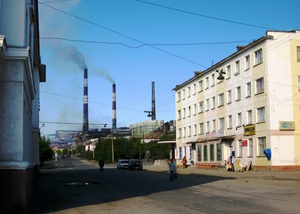
Norway’s environmental prosecutor fines Equinor a record amount following Bellona complaint
Økokrim, Norway’s authority for investigating and prosecuting economic and environmental crime, has imposed a record fine on Equinor following a comp...
News

Publish date: October 9, 2017
Written by: Anna Kireeva
Translated by: Charles Digges
News
Russian and Norwegian environmentalists and politicians gathering in the industrial town of Nikel to tote up advances in cross-border pollution for once had something positive to report: the joint efforts seems to be working.
The results of Russia’s Year of Ecology are so far mixed, but 2017 marks a quarter century since Russia and Norway started forging an often-brittle bond of environmental cooperation.
The event in Nikel – a company town to the Kola Mining and Metallurgy Company with a history of grievous pollution – was entitled “Days of Russian Norwegian near border cooperation,” and presented a best-foot-forward program that checked off several bilateral success stories.
Among them were air quality monitoring efforts jointly undertaken by authorities in Murmansk and Norway’s northerly Finnmark County; dual stewardship of protected lands, and water protection measures for area rivers.
The two regions have also formed a host of working groups on pollution reduction, biodiversity, cultural heritage and radioactive contamination.
 Spent nuclear fuel stored in so-called “bottles” at Andreyeva Bay.
Credit: Fylkesmannen i Finnmark
Spent nuclear fuel stored in so-called “bottles” at Andreyeva Bay.
Credit: Fylkesmannen i Finnmark
But the most celebrated achievement between the two countries this year is the advance made in removing the spent nuclear submarine fuel that piled up for five decades at Russia’s Andreyeva Bay, a mere stone’s throw from the Norwegian border.
Andreyeva Bay, a former Soviet Navy submarine maintenance yard on the Barents Sea, became a leak-prone Cold War dumping ground for more than 22,000 spent nuclear fuel assemblies, some of them damaged, and many stored in the open air with no protection.
But this summer, the two countries joined hands to make history, when nine of 450 containers of spent fuel were hauled away and sent by sea, then rail, to be reprocessed.
The removal process is expected to take five years, and both Russia and Europe have invested heavily in its success: Moscow has put $150 million toward the effort, and the West has contributed another $200 million.
Fittingly, the gathering took place in the Pasvik nature preserve, were authorities opened a tourist visiting at the beginning of 2017 to mark the Year of Ecology. Alexei Tyukavin, the Murmansk Region’s deputy governor, said the center came thanks to a cooperative effort between the region and Norilsk Nickel, a Russian industrial giant and one of the country’s biggest polluters.
Norilsk Nickel has a lot to answer for locally. Its daughter plant, the Kola Mining and Metallurgy Company, has belched sulfur dioxide throughout Northwest Russia and into Scandinavia since before the collapse of the Soviet Union.
The emissions have long been a source of bitter argument between Norway and Russia. But this year, for the first time after years of promises, the company posted sharp reductions in its sulfur dioxide emissions, shaving them by 20 percent over 2015 levels.
 The nickel smelting plant at Norlisk. Courtesy of Thomas Nilsen/The Barents Observer
The nickel smelting plant at Norlisk. Courtesy of Thomas Nilsen/The Barents Observer
At the gathering, diplomats from both sides of the border expressed their satisfaction with the emissions drop. Even Rune Rafaelsen, mayor of Kirkenes, Norway and one of the company’s most consistent critics, approved.
“The results are impressive,” he said. “Today we are happy to see that the company is really investing in environmental projects. Local residents deserve a better environment.”
Oskar Njaa, an advisor with Bellona who has studied the question of the sulfur dioxide emissions said the company’s efforts toward curtailing them is finally becoming visible. The company has recently made promises to cut its emissions even further, dropping them by 90 percent under 2015 levels.
But Njaa would like to see a more concrete plan toward these ambitious reductions – a plan that the company has so far been reluctant to spell out.
“Despite the fact that the company is realizing specific measures to reduce emissions, such as operating its briquetting factory at full capacity, the company’s general plan by which they will reduce emissions by 90 percent is still a riddle to us,” said Njaa. “We would really like to see such a plan, if it exists.”
Njaa was also concerned that the closure of a nickel facility at the company’s headquarters in Norilsk could lead to more ore being refined at the Kola factory.
This production change, he said, “could lead to structural changes in the industrial emissions and polluting substances issuing from the Kola Mining and Metallurgy Company.”
“This concerns not just sulfur dioxide emissions but pollution of water as well,” he said. “Only the company’s transparency can sooth these doubts.”

Økokrim, Norway’s authority for investigating and prosecuting economic and environmental crime, has imposed a record fine on Equinor following a comp...

Our op-ed originally appeared in The Moscow Times. For more than three decades, Russia has been burdened with the remains of the Soviet ...

The United Nation’s COP30 global climate negotiations in Belém, Brazil ended this weekend with a watered-down resolution that failed to halt deforest...

For more than a week now — beginning September 23 — the Zaporizhzhia Nuclear Power Plant (ZNPP) has remained disconnected from Ukraine’s national pow...